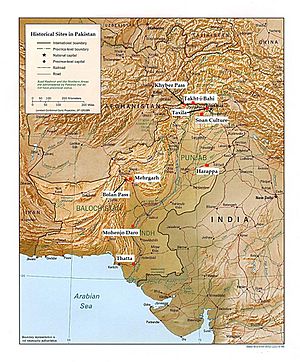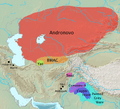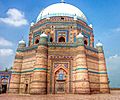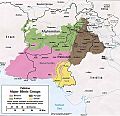History of Pakistan facts for kids
The people of Pakistan have a rich and varied history. Their heritage comes from many different groups who settled there over thousands of years. These groups include the Harappans, Aryans, Persians, Greeks, Sakas, Parthians, Kushans, White Huns, Arabs, Turkic people, Afghans, and Mughals. Many different invaders and migrants came to the region of Pakistan over the centuries. They influenced the local people and became part of the community.
Pakistan and India have their own unique histories. The land that is now Pakistan was only part of India for short periods. This happened for about 500 years under Muslim rule, and for 100 years each under the Mauryans and the British. In fact, ancestors of Pakistanis, like the Harappans, Aryans, Sakas, Kushans, White Huns, Turks, Afghans, and Mughals, often moved into and influenced northern India.
Contents
Early Civilizations in Pakistan
The history of Pakistan goes back thousands of years. Early human settlements and cultures developed in the Indus Valley.
The Stone Age and Neolithic Era
Around 50,000 BC, Stone Age civilizations lived near the Soan River Valley, close to Rawalpindi. Later, by 5100 BC, early Neolithic cultures began to grow. People in ancient Pakistan learned how to farm. They started raising goats and building houses from mud. They also learned to make baskets and pottery.
- 7000 BC: Farming began in areas like Baluchistan, Khyber Pakhtunkhwa, and Punjab.
The Indus Valley Civilization
The Indus Valley Civilization was a major early civilization. It thrived from about 2600 BC to 1900 BC. This was the start of city life in the region. It was centered around the Indus River and its smaller rivers, mostly in what is now Pakistan.
This civilization was known for its well-planned cities. These cities had buildings made of brick, good drainage systems along the roads, and houses with many stories. It is believed that changes in the environment, like deforestation and climate change, caused this civilization to decline.
- 2600 BC: The Indus Valley Civilization began in places like Kot Diji, Mohenjo-daro, and Harappa.
- 1700 BC: The Indus Valley Civilization ended. This happened as Aryans, who were cattle breeders, moved into their cities. The Aryans brought a strict caste system, which later became part of Hinduism. They also wrote the first Hindu scripture, the "Rig Veda."
Rise of New Powers
- 600 BC: Many people were unhappy with the caste system of Hinduism. Buddha, a prince, began to teach about equality for all humans. His ideas were popular in the northern parts of the subcontinent.
- Gandhara: The region of Gandhara became a powerful area. Its cities, "Pushkalavati" (now Charsada) and "Taxila," were important centers of culture and learning.
Persian and Greek Influences
Around the 5th century BC, the northwestern parts of the subcontinent faced invasions. First came the Persians, then the Greeks with Alexander the Great's army.
The Achaemenid Empire
Around 520 BC, Darius I of the Achaemenid Empire ruled a large part of northwestern India. Later, Alexander the Great conquered these areas. The historian Herodotus wrote that these lands were the richest parts of Alexander's empire. Persian rule lasted for about 186 years. Even today, you can find traces of this Persian influence in northwestern Pakistan.
The Greco-Buddhist Period
Greco-Buddhism is a mix of Greek and Buddhism cultures. This blend developed for 800 years, from the 4th century BC to the 5th century AD. It happened in areas that are now Afghanistan and Pakistan. This cultural mix greatly influenced Mahayana Buddhism and helped Buddhism spread to China, Korea, Japan, and Tibet.
- 327 BC: Alexander the Great invaded the subcontinent through the Khyber Pass.
- 323 BC: Alexander the Great died in Iraq.
- 321 BC: Chandragupta Maurya, a member of the royal family of Magadha, took control of Punjab. He then formed the Maurya Empire.
- 297 BC: Chandragupta Maurya, with his son Bindusara, expanded the Mauryan Empire. After Bindusara, his son Ashoka ruled with great kindness. He helped spread Buddhism across the subcontinent by building many Buddhist monasteries and stupas (dome-shaped shrines).
Later Invasions and Empires
- 195 BC: Demetrius, a king from Bactria, conquered the Kabul River Valley. He rebuilt Taxila and Pushkalavati (Charsada) as capitals of Gandhara.
- 75 BC: The Scythians, Persian nomads from Central Asia, followed Demetrius and captured parts of the subcontinent.
- 53 BC: The Parthians defeated the Greeks and ruled northern Pakistan. They encouraged art and religion, leading to the development of the Gandhara school of art.
- 64 AD: Kujula, a Kushan king from Central Asian nomad tribes, overthrew the Parthians and took over Gandhara. The Kushans expanded their rule from the Bay of Bengal to Bahawalpur, and even to Kashgar in China. They made Purushapura (now Peshawar) their capital.
- 128 AD: Kanishka, the greatest of the Kushan kings, ruled. Trade in jewelry, perfumes, spices, textiles, and medicine with the Romans grew. Thousands of stupas and monasteries were built, and the Gandhara school of art created beautiful sculptures.
- 151 AD: Kanishka's rule ended when he was killed.
- 300 AD: The Kushan Empire weakened due to attacks from the Sassanians in the North and the Gupta Empire in the South. The Kushan Empire became a smaller kingdom of Kidar Kushans, with Purushapura as its center.
- 400 AD: The White Huns, horse-riding nomads from China, invaded Gandhara. These Huns, who worshipped the sun and fire, caused the decline of the Gandhara school of art and Buddhism in northern Pakistan.
- 565 AD: The Sassanians and Turks defeated the Huns. The area was then mostly controlled by small Hindu kingdoms, with the Turki Shahi rulers in charge. Buddhism continued to decline as more people became Brahman Hindus.
- 870 AD: The Hindu Shahis, from Central Asia, overthrew the Turki Shahis. Their capital was Hund on the Indus River. Their kingdom stretched from Jalalabad to Multan and up to Northern Kashmir.
- 1008 AD: The Hindu Shahis' rule ended.
Arrival of Islam
The Islamic calendar (Hijri) began on July 16, 622 AD, when Prophet Muhammad (peace be upon him) migrated to Madina.
- 712 AD: Muhammad Bin Qasim arrived in Sindh through Daibal. This marked the beginning of Islamic influence in the region.
- 1097 AD: Shaikh Ab-al-Najib Suhrawardi, who founded the Suhrawardi Order (a Sufi group), was born.
- 1162 AD: Shaikh Ab-al-Najib Suhrawardi died.
- 1182 AD: Sheikh Baha-ud-din Zakariya of Multan, who brought the Suhrawardi order to Muslim India, was born.
- 1191-92 AD: Muhammad Ghauri defeated Prithvi Raj Chauhan in the battles of Taraori.
- 1194 AD: After the second battle, Muhammad Ghauri returned to Ghazni.
- 1238 AD: Sheikh Nizamuddin Auliya, an important Sufi saint, was born.
The Delhi Sultanate
- 1206 AD: After the death of Muizuddin Muhammad Ghauri, Qutbuddin Aibak took control of the subcontinent. He laid the foundations of the Delhi Sultanate, the first Islamic empire in the subcontinent. The Ilbari dynasty (also called the Slave dynasty, of Turkish origin) was the first ruling family of the Sultanate.
- 1217 AD: Shamsuddin Iltumish became the true founder of the Sultanate. He defeated his rivals and protected his kingdom from Mongol invasions.
- 1265 AD: Ghiasuddin Balban, a Turkish noble, took the throne after Mongol invasions in Northern Punjab.
- 1267-68 AD: Sheikh Baha-ud-din Zakariya died.
- 1286 AD: The Ilbari dynasty ended with the death of Ghiasuddin Balban. He had created a strong, centralized system of government.
- 1290 AD: The Khaljis, also of Turkish origin, became the second dynasty of the Delhi Sultanate.
- 1320 AD: The Tughluqs, the third Turkish dynasty of the Delhi Sultanate, came to power.
- 1325 AD: Sheikh Nizamuddin Auliya died.
- 1414 AD: The Saiyads, the fourth dynasty of the Delhi Sultanate, took control.
- 1451 AD: The Lodhis, of Afghan origin, became the fifth dynasty of the Delhi Sultanate.
The Mughal Empire
- 1526 AD: The Lodhis were defeated by Zahiruddin Babur at the Battle of Panipat. This marked the beginning of the Mughal Empire.
- March 16, 1527: The Battle of Kanwaha took place between Babur's forces and Rana Sanga of Mewar, a Rajput prince. Babur's forces won this important battle.
- 1528 AD: Babur captured Chanderi from the Rajput chief Medini Rao.
- 1529 AD: Babur's forces continued their victories, defeating Afghan chiefs under Mahmud Lodhi at the Battle of Ghagra.
- December 26, 1530: Zaheeruddin Babur died in Agra.
- 1530 AD: Humayun, Babur's eldest son, took control of the Mughal Empire.
- 1540 AD: Sher Shah Suri defeated the Mughals in the battles of Chausa and Kanauj. Mughal king Humayun had to live in exile for almost 15 years. This was a temporary setback for the great Mughal Empire.
- 1545 AD: Sher Shah Suri died. His son, Hasan Shah Sur, continued the Suri dynasty.
- 1555 AD: Humayun regained power.
- 1556 AD: The true foundations of the great Mughal Empire were laid by Akbar after Humayun's death. Akbar was only 13 years old, but his guardian, Bairam Khan, helped him establish a vast empire through many conquests.
- June 26, 1564: Sheikh Ahmad was born. He became an important Islamic scholar who promoted a philosophy of dedication to Islam.
- 1572 AD: Akbar conquered Gujrat and renamed it Fatehpur. He built the Jamia Masjid with its impressive red stone gateway, known as Buland Darwaza, in this new capital.
- 1581 AD: Akbar introduced Din-i-Ilahi, a new religion that was seen as a threat to Islam at the time.
- 1583 AD: The British first arrived in the subcontinent as traders. Queen Elizabeth sent a ship called Tygar to explore trade opportunities.
- 1605 AD: Jahangir's reign began after Akbar. Jahangir, whose original name was Salim, was Akbar's son. During his rule, Mughal power reached its peak. Mughal architecture saw a shift from red stone to white marble. Famous gardens like the Shalimar Garden in Lahore were built. Mughal painting also reached its highest point during Jahangir's time.
- 1614 AD: The British East India Company opened its first office in Bombay.
- 1628 AD: After Jahangir's death, his son Khurram became Shah Jahan. He further expanded the empire to Kandahar and conquered much of southern India. Shah Jahan's reign was the golden period of the Mughal Empire. White marble became a key feature in architecture, seen in structures like Dewan-e-Aam in Agra, Moti Masjid, Shish Mahal, and Dewan-e-Khas in Lahore Fort.
- 1631 AD: Construction began on the Taj Mahal, a beautiful mausoleum for Shah Jahan's wife, Arjumand Banu Begum.
- 1653 AD: The Taj Mahal, one of the wonders of the world, was completed, showcasing the glory of Mughal architecture.
- 1658 AD: Aurangzeb Alamgir's reign began after Shah Jahan's death. The Badshahi Mosque, the largest mosque of its time, was a great achievement during Aurangzeb's rule. Despite this, Aurangzeb also gave many grants to Hindus, appointing them to important government positions and allowing them to restore temples. The Mughal Empire began to decline after this period.
- February 21, 1703: Shah Wali Ullah, an important Islamic reformer, was born.
- 1707 AD: Aurangzeb died, and the Mughal Empire started to decline. Although Bahadur Shah Zafar, Aurangzeb's son, took control, the Marathas in the Deccan and Sikhs in Punjab grew stronger. These new powers continued to rise until 1857. Shah Wali Ullah's reform movement also began around this time.
- 1738-39 AD: The weakening Mughal Empire attracted Nadir Shah, a Persian king. Afghans of Rohilkhand and Jats also became threats to the empire.
British Rule
- 1757 AD: The East India Company became deeply involved in Indian politics. After the Battle of Plassey, the British began their systematic conquest of the subcontinent.
- 1830 AD: Haji Shariatullah started the Faraizi Movement in East Bengal.
- 1835 AD: English was declared the official language of the subcontinent by the British.
- 1840 AD: Haji Shariatullah died. His son, Muhammad Mohsin (known as Dadhu Mian), made the Faraizi Movement stronger.
- 1845 AD: The British Empire had grown from Bengal to Sindh, but Punjab was still ruled by the Sikhs.
- 1848 AD: After the Second Sikh War, the British took control of Punjab and the Indus Valley.
- November 1, 1857 AD: Pakistan became part of the British Raj, a foreign colonial empire.
- 1860 AD: Muhammad Mohsin (Dadhu Mian) died.
Images for kids
-
Archaeological cultures. The GGC, Cemetery H, Copper Hoard and PGW cultures are candidates for cultures associated with Indo-Aryans.
-
Mauryan Empire under Ashoka the Great
-
The Bimaran casket, representing the Buddha surrounded by Brahma (left) and Śakra (right) was found inside a stupa with coins of Azes inside. British Museum.
-
Gandhara Buddhist reliquary with content, including Indo-Parthian coins. 1st century CE.
-
Early Mahayana Buddhist triad. From left to right, a Kushan devotee, Maitreya, the Buddha, Avalokitesvara, and a Buddhist monk. 2nd–3rd century, Gandhara.
-
The Gupta Empire at its maximum extent, under Chandragupta II, c. 414 AD, including tributaries
-
Vishnu Nicolo Seal representing Vishnu with a worshipper (probably Mihirakula), 4th–6th century CE. The inscription in cursive Bactrian reads: "Mihira, Vishnu and Shiva". British Museum.
-
The Bala Hissar fort in Peshawar was one of the royal residences of the Durrani kings.
-
Lord Minto met with the Muslim delegation in June 1906. The Minto-Morley Reforms of 1909 called for separate Muslim electorates.
-
Chaudhry Khaliquzzaman seconding the Resolution with Jinnah and Ali Khan presiding the session
-
Karachi War Cemetery. About 87,000 soldiers from British India (which includes modern India, Pakistan and Bangladesh) died in World War II. Millions of civilians also died due to famines.
-
Mazar-i-Quaid, the tomb of Muhammad Ali Jinnah
-
Procession march held on 21 February 1952 in Dhaka
-
In 1955, the One Unit Scheme integrated the four provinces of the western wing of Pakistan into a single province, West Pakistan.
See also
 In Spanish: Historia de Pakistán para niños
In Spanish: Historia de Pakistán para niños



































